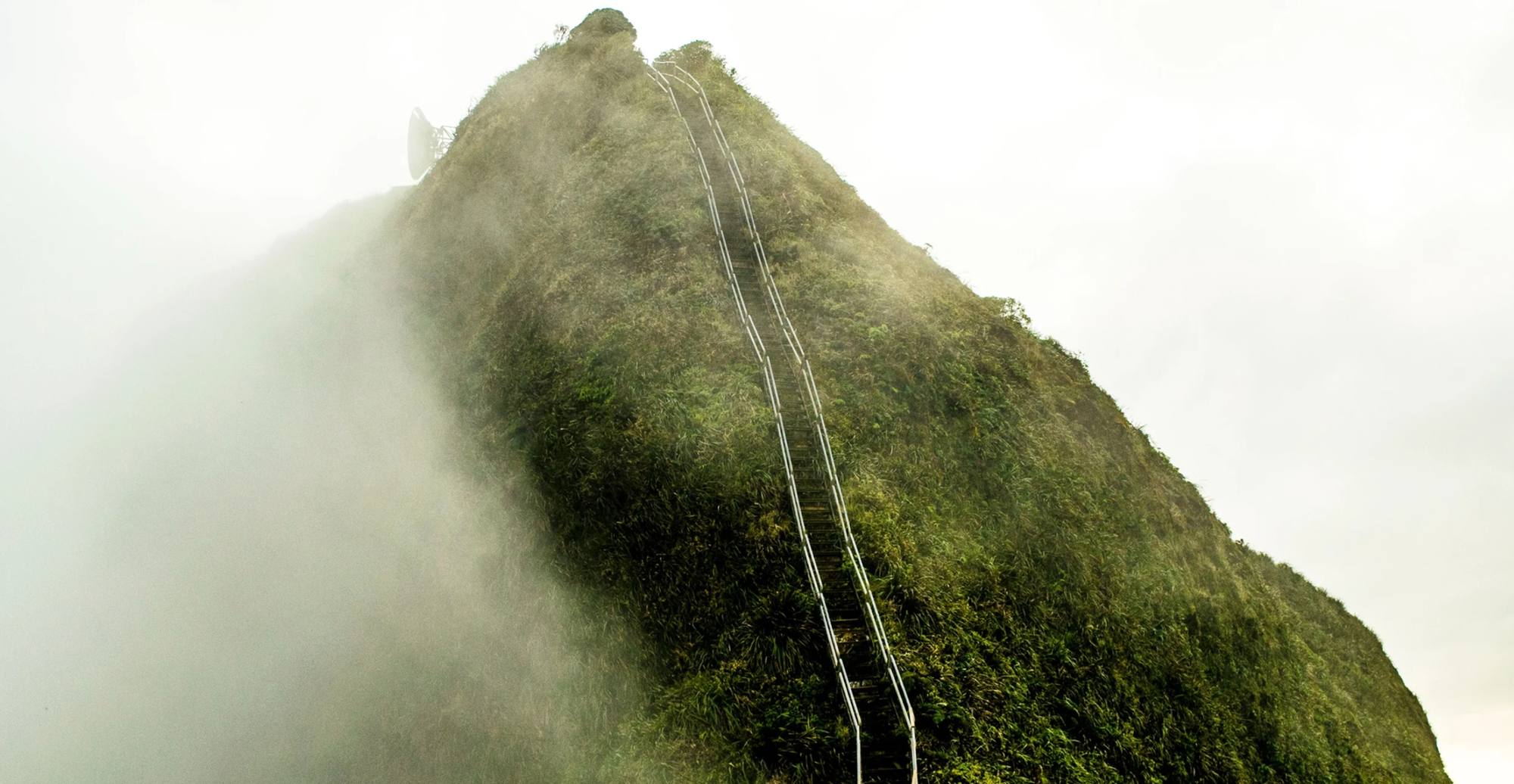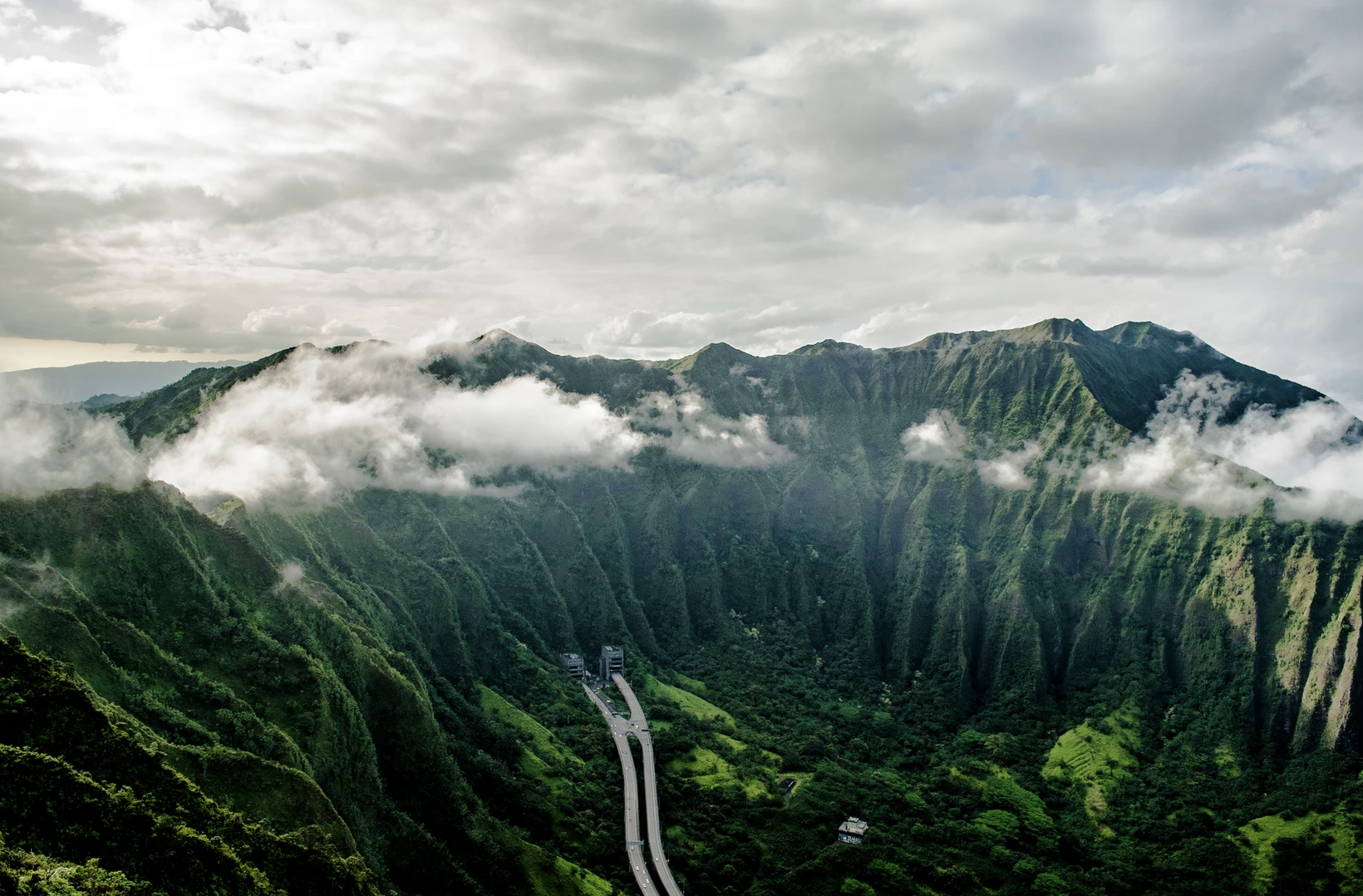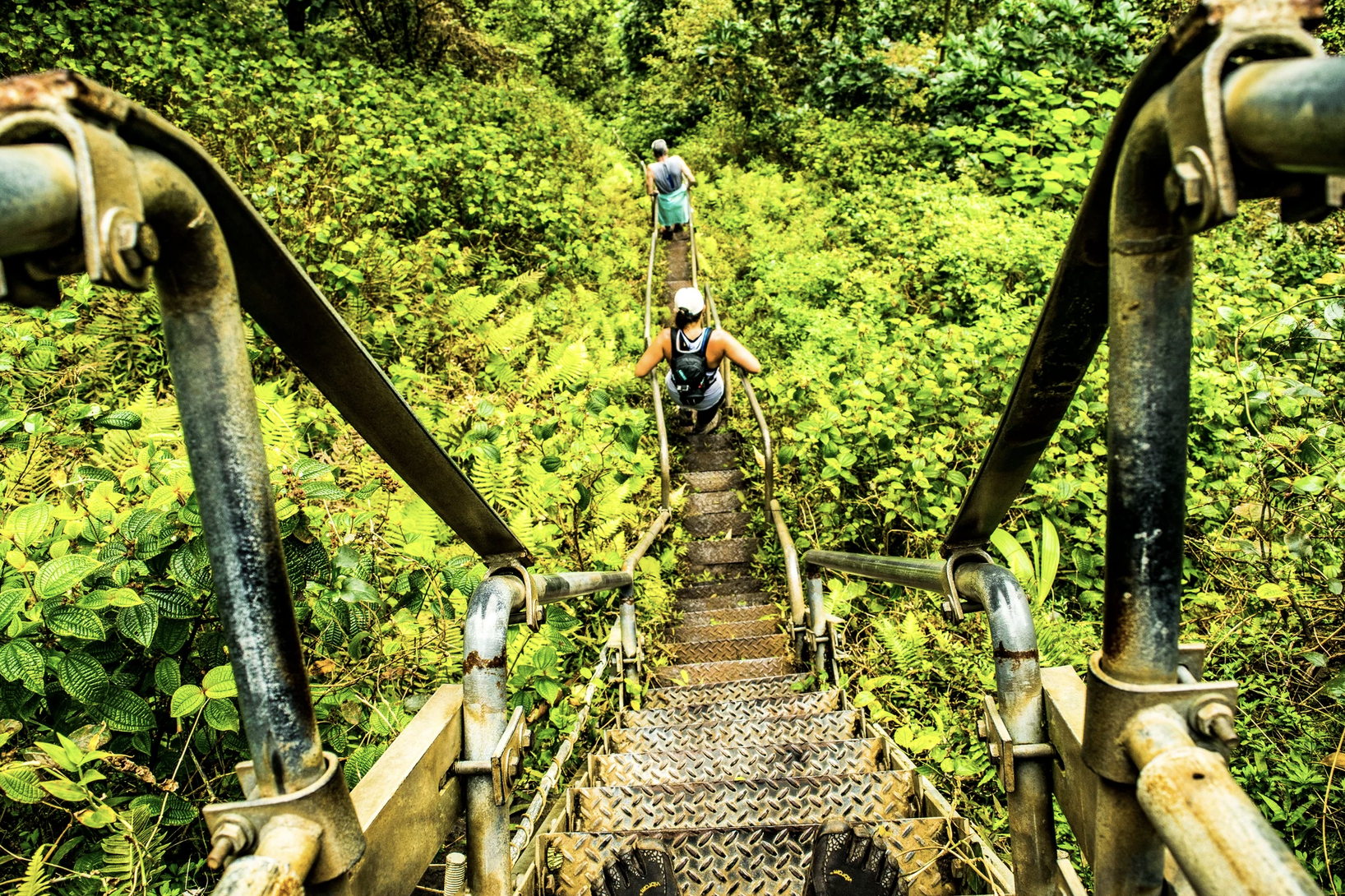We’ve all seen the photos. A thin chain of steel stairs and handrails climbs a verdant jungle ridgeline, misty skies on either side. Often there’s a rainbow in the background. In short: paradise on earth.
The Haʻikū/Haiku Stairs (better known as the “Stairway to Heaven”) is perhaps one of the world’s most photographed hikes, and certainly the most famous hike in Hawaii. Chances are you’ve seen the photo above (or one like it) before reading this article. But although the 3,900-step stairway is extraordinarily popular with hikers—both locals and mainlander tourists—they’ve been “technically” closed to the public for nearly their entire existence.
Built by the U.S. Navy during World War II to service a radio facility on a remote peak above Oahu’s Haʻikū Valley, this steep, winding path of metal stairs was opened to the public in the 1970s, but soon closed again due to vandalism and overcrowding. In the last fifty-odd years, ownership changed hands a couple of times, and the city even paid nearly a million dollars to repair the stairs in 2003, but they’ve stayed officially “closed” to the public. (This, of course, hasn’t stopped scores of hikers from climbing them.)
Nonprofit group Friends of Haʻikū Stairs (FHS) has been advocating for the route since 1987. The group formerly led tours up and down the hike, and has provided routine maintenance and upkeep—tightening bolts and clearing trash and overgrowth from around the route—up until 2021, when the city restricted their access.
But after the Honolulu City Council voted unanimously to demolish them in August of that year, the fight to secure access to the Haʻikū Stairs became a literal fight to save them. The stairs were scheduled to be dismantled and winched out by helicopter this month, in an effort reportedly siphoning city tax dollars to the tune of $4.5 million. A lawsuit filed by the FHS has paused the demolition pending a court hearing scheduled for May 10.
The World’s Most Controversial Staircase?
Why do people want to tear down the Haiku Stairs?
The issue is complicated, says FHS treasurer and board member Ernest Shih, who has lived on Oahu for 40 years and runs a small coffee shop, Cafe Kopi, in the town of Kailua, near the base of the stairs.
According to Shih and the FHS, it’s not a question of “locals vs. tourists” as some might think. It’s true that most of the hikers on Oahu are visitors (the island hosts millions of tourists annually). However, the FHS also commissioned an independent survey of 5,000 residents in Kāneʻohe and the Haʻikū Valley in 2022, and more than 90% favored preserving the Stairs. A Change.org petition also currently has over 12,000 signatures in support of preservation.
“It’s a small and influential group of people, mostly wealthy private landowners near the Stairs, who have a problem with it,” Shih said. (Admittedly, these landowners have dealt with rampant trespassing, littering, and illegal parking over the years.)

The FHS isn’t advocating for the keeping things as they are. Shih says they recognize the problems the stairs have caused for the handful of neighbors. The group has constructed a publicly available 20-page plan for sustainable managed access, including security, parking, and visitor registration. “There are multiple ways to get to the stairs without going through that neighborhood,” Shih said.
Former Honolulu Mayor Kirk Caldwell was in favor of keeping the stairs, and 14 local entities—including sprawling nature reserve Kualoa Ranch—responded to a public request for interest in managing the stairs in 2020. However, when new city mayor Rick Blangiardi took over in early 2021, these plans were scuttled in lieu of demolition.
“We don’t care who manages it,” Shih said. “We just want to save the damn thing. We’ve done a profit analysis, and the city could be making a ton of money by preserving these stairs and opening them to the public, instead of spending all this money to tear them down.” Current and past issues with trespassing are a moot point, Shih said, because, “No one has ever given managed access a try.”
In addition to the high cost of removal—which has already climbed from $1 million to $4.5 million—the FHS maintains removal could cause “serious harm to endangered species living in critical habitats around the Stairs, and “soil runoff harming the downstream watershed leading into Kāne‘ohe Bay.”

Will Removal Make Things Better, or Worse?
Even if it goes ahead, FHS believes the removing the stairs isn’t going to change anything. The removal plan entails chopping the bolts anchoring the staircase and hauling the structure out piecemeal by helicopter, but the skeleton will still exist along the ridgeline, akin to chopped bolts on a sport climbing route. “Climbers are still going to come and try to clip into these stakes to climb it,” Shih said. “It’s not going to stop people.”
He may be right. Even as construction crews began surrounding the stairs in advance of its likely demolition in the last couple of weeks, hundreds of hikers have received citations and warnings for trying to climb the stairs.
Beyond the trespassing and littering, the cost of rescues and security on the stairs are a leading case for removal. The Honolulu Fire Department has rescued over 100 people on the Haiku Stairs since 2010. However, statistics show that more hikers are rescued on the circuitous legal Moanalua “back route” to the top of the staircase, and removing the Haiku Stairs may only funnel hikers to this longer, riskier, and more strenuous route. There have never been any deaths or serious injuries as a result of a fall on the Haiku Stairs (though one hiker did die of a heart attack from exertion), nor any lawsuits to the City of Honolulu.

The Haiku Stairs may be Hawaii’s most famous hike, but it’s not the first legendary route to be threatened with demolition. From Dead Man’s Catwalk to Mariner’s Ridge, a number of privately-owned hikes on Oahu have been shut down over the years for similar concerns. Managed access has also saved some, like the Koko Crater Stairs, a defunct tramway line running to the summit of Pu’u Mai (1,211ft) that is now open to the public for free thanks to management and maintanence by an eponymous nonprofit.
“Look, if there was a public referendum on the stairs, preservation would pass easily,” Shih said. “[The city council] smashed this vote through during COVID, when everyone was stuck at home. You had to make comments online, you couldn’t go in person, and even then the majority of comments were like ‘No, we want to keep it.’ It would really be a shame to lose the Stairs,” Shih continued. “They’re historic, could bring a lot of money to the city, and there are plenty of groups out there interested in managing access safely and effectively.”
“This hike is popular for a reason. It’s one-of-a-kind. It should be there for everyone to enjoy.”
In addition to donating, interested readers are encouraged to visit the Honolulu District Court at 1111 Alakea St. Honolulu, HI 96813 at 9:00 a.m. May 10 to support the FHS during their hearing.

